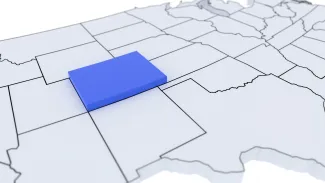
Colorado has new tool for preserving aquifers for farming
Click play to listen to an abbreviated version of this article.
On a dry, hot day in June, water manager Chris Ivers plunged his hand into San Luis Creek and extracted a tangled mat of weeds that had blocked icy snowmelt from reaching nearby farms. The free-flowing water is a welcome sight in southern Colorado, an agricultural region in the throes of a groundwater crisis.
Ivers, who helps farmers and ranchers in this arid valley use the scarce resource wisely, pointed out the full ditch and green shoots emerging nearby-a byproduct, in part, of a regional experiment in water conservation. "I'm encouraged," he said as crows squawked overhead and mustard grass waved in a slight breeze. "I really haven't been walking out here in a while."

© iStock - Molina86
Producers in this sprawling valley, cradled between the San Juan and Sangre de Cristo mountains, have just seven years to replenish overtapped groundwater to levels required by law or face state-mandated well shutdowns. Aquifer storage plunged in 2002 on the heels of a severe drought and hasn't markedly recovered, and much of the region is currently under a federal disaster declaration. Following the 2002 drought, farmers voluntarily created seven governing bodies, called water subdistricts, in the hopes of replenishing two aquifers that make growing food viable here in North America's largest high-altitude desert.
Fields in the San Luis Valley yield two billion pounds of potatoes a year, making the region the nation's second-biggest spud producer. But the valley's irrigation outlook is dire: Water withdrawn by wells exceeds the amount of snowmelt refilling aquifers, and there are more claims to water rights than there is water in streams. The expanse is among the most densely irrigated regions on Earth. To reach that seven-year target, farmers and residents will have to further curtail water use by retiring wells, fallowing fields, and switching to less water-intensive crops; otherwise, the state engineer may intervene and order well curtailments.
That puts Ivers, a program manager for two subdistricts with the Rio Grande Water Conservation District, at the center of difficult decisions about how to use, and conserve, the valley's shrinking water supplies. He is also implementing an innovative project designed to add water back into the aquifer. If successful, the experiment could provide a roadmap for hundreds of farming and ranching communities nationwide whose groundwater stores are dwindling at unprecedented rates.
An 'All Hands' Crisis
At Peachwood Farms, a flat, 1,897-acre expanse at the heart of the valley's groundwater conservation trial, Ivers stood amid fallowed fields bordered by circles of barley and areas being revegetated with native seeds. This patchwork of land marks the personal sacrifices that are keeping the region's agricultural industry-its largest employer-alive.
"If you ask somebody who works in water like me, this looks great," Ivers said, as pronghorn observed him from a distance and a golden eagle circled overhead. The goal, he added, is to significantly curtail water use on the property in order "to help make farming in the rest of this region more sustainable."

In 2022, the nonprofit Colorado Open Lands forged what's known as a groundwater conservation easement with Peachwood Farms' owner. The agreement retired pumping on seven of 12 crop circles over the next decade and halved water use from the remaining five, in exchange for an undisclosed cash payment to the farm and state and federal tax credits. The easement saved 560 million gallons a year and made the aquifer in this part of the valley whole. The unconventional deal ensured that the property's neighbors, like David Frees, will not face well shutdowns, and is an example of the kind of complex solutions needed to keep farms going in the current climate.
"The Peachwood easement allowed us to drop groundwater pumping [in the subdistrict] by 10 percent," Frees said in a recent interview. "Without it, we might have had to curtail everyone's water use by 10 percent."
Instead, the easement allowed the subdistrict's farmers to continue their operations much as they have in the past, said Frees, who runs 60 head of cattle and is president of one of the valley's seven water subdistricts. "As the aquifer fills up, we will have more stream flow extend to other parts of the valley."
Groundwater depletion is by no means unique to this corner of Colorado. Across the U.S., groundwater stores are in the red and dropping fast. Aquifers that farmers rely on for irrigation in California, Arizona, New Mexico, Nebraska, and elsewhere have fallen by dozens of feet since 2002, satellite imagery shows.
Amid this national crisis, the attempts by the farmers in the San Luis Valley to moderate their own use caught the eye of U.S. Senator Michael Bennet (D-Colorado). In 2023, Bennet introduced a bill in the Senate that would increase nationwide funding for groundwater conservation easements akin to the one on Peachwood Farms. Bennet is currently working with fellow senators to include either funding for such programs or a pilot groundwater easement project in the 2024 Farm Bill, said Rosy Brummette Weber, a policy advisor to Bennet.
The Peachwood Farms groundwater conservation agreement has also prompted water managers in overdrafted basins from California to Kansas to approach Colorado Open Lands for information on how to use similar arrangements to preserve water for their growers.

© joshschutz - iStock-133883324
The stakes are high and mounting: The nation's aquifers are dwindling due to rising temperatures, drought, and overuse. Many are not replenishable. Disappearing groundwater threatens the livelihood of crucial agricultural regions like the San Luis Valley, which in turn diminishes the national food system, making the U.S. more reliant on imports. The breadth of the problem prompted President Biden's Council of Advisors on Science and Technology to issue a warning in December, calling the crisis "an all-hands-on-deck moment for groundwater sustainability."
The refusal of some growers nationwide to curb groundwater pumping became evident in May, when Idaho's water agency ordered limitations on the use of wells serving a half million acres of agricultural land, an action described as "the largest curtailment" in state history.
In southwestern Colorado's high desert, producers already till fewer acres, tax themselves to fund fallowing programs, and plant less water-intensive crops. Taxpayers are also footing the bill for a $30 million programapproved by the state legislature, in which the Rio Grande Water Conservation District uses funding from the American Rescue Plan Act to pay farmers for retiring their wells.
Yet even after growers here cut pumping by a third, in 2022, water in one of two aquifers fell to its lowest level on record, after extreme heat led to diminished snowpack. Throughout the West, the snowpack of the mountains acts as water bank, with snowmelt filling creeks and streams throughout the summer that help irrigate fields and recharge the aquifer. (The San Luis Valley floor receives only seven inches of rain per year.)
To ensure its aquifers remain sustainable amid an uncertain climate future, the Rio Grande Water Conservation District must permanently withdraw up to 60,000 acres of land from irrigation, about 10 percentof the valley's arable land. After two decades of effort, the aquifers are only a third of the way charged, and frustration with the pace of recovery is high among water managers, producers, and residents.
"The aquifer has not recovered, and we have spent tens of millions of dollars on programs to reduce groundwater withdrawals," said Amber Pacheco, the Rio Grande Water Conservation District's deputy general manager, who oversees irrigators in six subdistricts. (A seventh is operated by the Trinchera Ground Water Management Subdistrict.) Some of the region's subdistricts still haven't seen any aquifer recovery and, she added, they "are in a fight against Mother Nature."
Easements Ain't Easy
Most of the water-saving programs in the valley so far have focused on short-term drying up of land. None have created perpetual groundwater savings or allowed people to keep farming by reducing irrigation over their entire property.
Enter groundwater conservation easements. These are legal tools that restrict pumping on a certain piece of property, and in the arid West and Midwest, they present innovative solutions to aquifer depletion.
Such agreements, like the one forged on Peachwood Farms, allow growers to reduce the number of acres they plant, and thus the amount of water they use, in perpetuity, in exchange for federal and state tax benefits. These agreements can overlap with other solutions. The Rio Grande Water Conservation District, for example, is using money from the USDA's Natural Resources Conservation Service to revegetate easement land with drought-resistant native and non-native plants.
Even so, this promising tool faces challenges to its potential. Chief among them are both a lack of funding for such deals and the fact that appraisers who value conservation easements are unsure how to put a value on groundwater.
"People call me and say they want to put in place a groundwater conservation easement and I say, 'That's great: We have no idea what we would pay you,'" said Sally Wier, groundwater conservation project manager at Colorado Open Lands, who lives and works with producers in the San Luis Valley. "I have people who are 70 years old, and they are trying to decide whether to fallow their land or stay optimistic and continue farming."
Appraisers are adept at valuing traditional conservation easements, in which farmers and ranchers receive tax breaks and grants in exchange for placing deed restrictions on their operations that bar most development. Such deals exploded in popularity over the last decade as agricultural producers sought to stave off big-box stores, self-storage complexes, and residential construction, all of which already consume millions of acres of fertile open space. But applying the same approach to water is tricky.
The Spread of Innovative Easements
In the San Luis Valley, Colorado Open Lands also pioneered a conservation easement program that ties surface water rights to the land. This legal assistance project paired farmers with law students to formalize verbal water-sharing agreements into bylaws. As a result, it preserved a network of centuries-old irrigation ditches known as acequias, whose operators hold the state's oldest water rights.
Similar efforts are underway elsewhere in the West. Just a six-hour drive to the south, near Clovis, New Mexico, lies another arid region desperate to replenish its drought-stricken aquifer.
Here, the Ogallala Land and Water Conservancy is pursuing short-term conservation easements on groundwater rights while it works to secure more funding for perpetual deals. It's a sprint to refill the massive Midwest aquifer, which spans eight states and declined about 17 feet, on average, from when irrigation began in the 1950s through 2017, a U.S. Geological Survey study found.
The diminished water supply requires sacrifices like those made on Peachwood Farms. Eight landowners have forged groundwater leases with the conservancy in which they've agreed to stop pumping from 51 wells, saving about 4 billion gallons a year. Their actions will help secure groundwater supply for Cannon Air Force Base, the city of Clovis, and Curry County-and will protect habitat for endangered species.
To figure out how to fairly compensate the landowners for their water, the conservancy installed a special flow meter on center-pivot sprinklers to calculate total gallons per minute of annual groundwater production, said Ladona Clayton, the Ogallala Conservancy's executive director.
The organization also reviewed crop budgets to analyze harvests over previous years and the herbicides used, as well as insurance, labor, and other production costs, she added. Using about $5 million in federal and state funds, it then annually paid the landowners for 100 percent of the appraised value of their groundwater, allowing them to keep 20 percent of their water. Agreements extend for three years while the nonprofit works to secure further funding for conservation easements.
"These producers who have lease agreements shut off wells in 2022, many that were dry on certain parts of their land," Clayton said. "Now those wells have water-it's music to my ears-they can haul water for their livestock."
Such deals are showing promise, and more will be needed. Extended drought throughout the West is unlikely to abate, nor is demand for water.
Meanwhile, farmers in the San Luis Valley who raise livestock near Peachwood Farms hold high hopes for the groundwater conservation easements. Such deals may eventually play a key part in the ongoing effort to restore the region's aquifer system.
"I'm the fifth generation to farm in the area, and I wouldn't mind doing more deals" like Peachwood, said Pete Stagner, who is vice president of the water subdistrict overseen by Frees and runs 200 head of cattle on a ranch adjacent to Peachwood. "I'm hoping that I can see in my lifetime that our aquifer can get back up to where it was in the 1950s."
Jennifer Oldham wrote this article for Civil Eats.

















